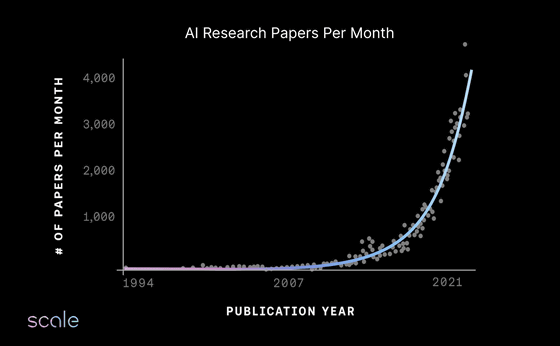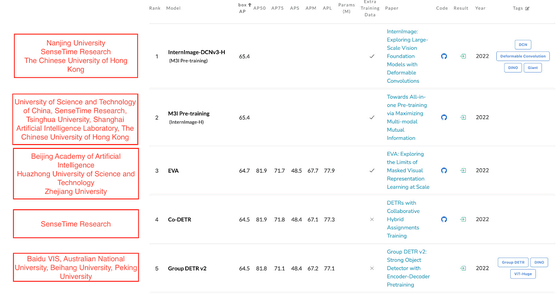How to Win an AI War?

Warfare and its deterrence are now defined by AI, and whoever wins the AI race will gain economic and military dominance. Alexandre Wang, CEO of the rapidly growing AI platform '
The AI War and How to Win It - by Alexandr Wang
https://alexw.substack.com/p/war
Wang says AI-based technology will be heavily used in warfare. In fact, since Russia's invasion of Ukraine in February 2022, the Ukrainian Ministry of Defense has used facial recognition technology to identify Russian agents and war dead, and to analyze war damage from aerial photographs . AI is active, and AI is also used in the war scene. But Wang added, ``In the near future, autonomous drones that use AI to identify targets will define warfare.''
Ukraine starts using Clearview AI's face recognition technology, whether it is used to identify Russian war dead and operatives - GIGAZINE

According to Wang, the pace of AI research uniquely follows Moore's Law , with the number of AI papers published per month doubling every two years. ``While there is a renaissance of AI in the commercial sector, the application of AI to military power and the obvious risks of America being overtaken by other countries are not being addressed,'' Wang said. .

Wang cites China's growth as the most important threat. China's semiconductor technology has made remarkable progress, and China sees AI as a 'historic opportunity for breakthrough development' in national security technology. According to Wang, China believes that 'the United States is in the classic 'innovator's dilemma'', overinvesting in mature systems because of progress and overinvesting in new disruptive technologies, AI. China, which has a thinner base of the existing defense industry, will have a much greater advantage in AI than the United States, which underestimates investment.
In addition, China's military sector spends 1% to 1.5% of the total defense budget of 178 billion dollars (about 25 trillion yen) in 2020 on AI, while the United States spends only about 0.1% to 0.2% of the defense budget. China spends more than ten times its total military budget compared to nothing. The US government is actually aware of the threat, and in October 2022, the US announced rules to crack down on semiconductor exports to China, fearing China's AI-based weapons development.

Wang also shows that China's AI has already surpassed America's in some technological areas. The following images are the top 5 algorithms for image recognition using established benchmarks, all of which are produced by Chinese companies and universities.

In addition, the following is the global challenge ranking for object detection from aerial images. Except for a Korean university in 3rd place, Chinese companies and universities ranked 1st, 2nd, 4th, and 5th. have earned.

Furthermore, in the field of large-scale language models (LLM) for natural language understanding and inference, OpenAI , a major American company, is leading, but its lead follows that of Chinese companies within a year. Mr. Wang points out that it is.
Another point Wang argues that China has the upper hand in the AI field is that China uses AI relentlessly. The Chinese government uses AI technology to create a fake article that the United States has abandoned Taiwan's support during the election, and the government introduces an algorithm to track Uyghurs in the country. without hesitation. In addition, Mr. Wang is concerned about the possibility of China invading Taiwan by around 2028, warning that it will be pressure as a time limit.
Recognizing that the current AI operating model is doomed as a way for the US to win AI development against China's rapid growth, Wang has developed four strategies that he dubs 'AI Overmatch Strategies.' I am proposing.
・Maintain data superiority
AI will always come down to data, so if we can turn America's strength in massive military hardware into a data advantage through investment in data equipment, we'll be one step ahead, Wang said. said. First of all, it is important to recognize the internal military data that has been destroyed or concealed as superior.
・Draft a 10-year plan for AI as a long-term investment
China has a 10-year plan for its AI strategy, and to compete with it, it still needs to draw a long-term path, Wang said. A military force that is not AI-enabled will be of little use in the fight against AI, Wang said, so investment in non-AI capabilities will be cut short, either modernizing existing military capabilities with AI or replacing traditional military capabilities. You will have to choose whether to abolish it and create a new ability that supports AI.
・Invest in innovative challenges
The largest-ever program launched within the U.S. Department of Defense has, after five years, still failed to operationalize a major AI capability that could disrupt today's fighter jets. In this way, focusing on maintaining existing technology slows progress significantly, so Mr. Wang recommends investing in innovative programs that disrupt existing concepts.
・Investment in people to acquire skills
As technology advances, humans will not always stay away from warfare, and we need to invest in AI and train military personnel on AI fundamentals at the same time. Military commanders also need to know how to use military-internal data as an asset. Mr. Wang concludes that the Department of Defense needs to renew principles and concepts in recognition of an AI-enabled future, rather than simply adding AI to the traditional concept of warfare.
Related Posts:
in Software, Posted by log1e_dh







